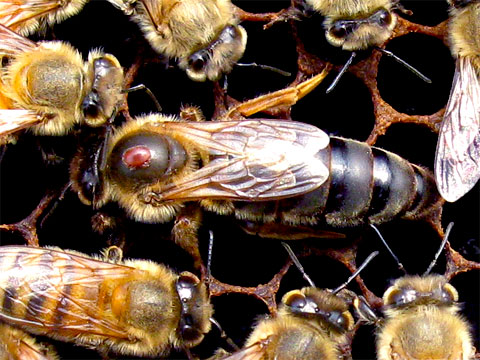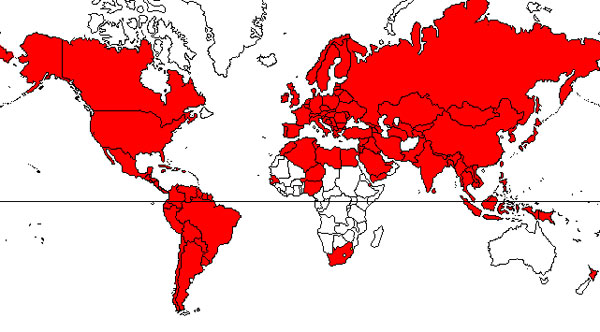Bees and beekeeping have held a great importance to many cultures through history particularly prior to the arrival of sugar cane to colder areas of the world. A European tradition that was held by some beekeepers was referred to as "Telling the Bees". This involved informing the bees of any important family events like birth, marriage or death. Beekeepers would often leave small offerings like wedding cake or small sweets for a birth and drape the hives with black cloth or turn the hives away from the house upon death. It was said that the bees would either die or leave the hives if not told of the death of their keeper. This tradition was brought to the Americas by immigrants in the 19th century.
In Mark Twain's Huckleberry Finn he wrote:
This video is of a Dutch beekeeper in l926 telling the bees of a death. A black cloth is draped over one of the hives and he taps on each of the hives to get there attention to deliver the news. In Holland it was customary to use a pipe as a smoker to calm the bees. (Historical Honeybee Articles)
“And he said if a man owned a beehive and that man died, the bees must be told about
it before sun-up next morning, or else the bees would all weaken down and quit
work and die. Jim said bees wouldn't sting idiots; but I didn't believe that,
because I had tried them lots of times myself, and they wouldn't sting me.”
Another example of "Telling the Bees" is in England in 1840, a woman upon the death of their keeper leaving an offering of sweets and reciting the poem:
Your master J.A. has passed away.
But his wife now begs you will freely stay,
and still gather honey for many a day.
Bonny bees, Bonny bees, hear what I say.
The process is described in 1901 work of Samuel Adams Drake A book of New England legends and folk lore in prose and poetry:
...goodwife of the house to go and hang the stand of hives with black, the usual symbol of mourning, she at the same time softly humming some doleful tune to herself. (Wikipedia)
This video is of a Dutch beekeeper in l926 telling the bees of a death. A black cloth is draped over one of the hives and he taps on each of the hives to get there attention to deliver the news. In Holland it was customary to use a pipe as a smoker to calm the bees. (Historical Honeybee Articles)
Here is a poem written by John Greenleaf Whittier about "Telling the Bees" of their keepers passing.
Telling
the Bees
(The
traditional telling the bees
of a recent beekeeper passing)
Here
is the place; right over the hill
Runs
the path I took;
You
can see the gap in the old wall still,
And
the stepping-stones in the shallow brook.
There
is the house, with the gate red-barred,
And
the poplars tall;
And
the barn's brown length, and the cattle-yard,
And
the white horns tossing above the wall.
There
are the beehives ranged in the sun;
And
down by the brink
Of
the brook are her poor flowers, weed-o'errun,
Pansy
and daffodil, rose and pink.
A
year has gone, as the tortoise goes,
Heavy
and slow;
And
the same rose blows, and the same sun glows,
And
the same brook sings of a year ago.
There's
the same sweet clover-smell in the breeze;
And
the June sun warm
Tangles
his wings of fire in the trees,
Setting,
as then, over Fernside farm.
I
mind me how with a lover's care
From
my Sunday coat
I
brushed off the burrs, and smoothed my hair,
And
cooled at the brookside my brow and throat.
Since
we parted, a month had passed,--
To
love, a year;
Down
through the beeches I looked at last
On
the little red gate and the well-sweep near.
I
can see it all now,--the slantwise rain
Of
light through the leaves,
The
sundown's blaze on her window-pane,
The
bloom of her roses under the eaves.
Just
the same as a month before,--
The
house and the trees,
The
barn's brown gable, the vine by the door,--
Nothing
changed but the hives of bees.
Before
them, under the garden wall,
Forward
and back,
Went
drearily singing the chore-girl small,
Draping
each hive with a shred of black.
Trembling,
I listened: The summer sun
Had
the chill of snow;
For
I knew she was telling the bees of one
Gone
on the journey we all must go!
Then
I said to myself, 'My Mary weeps
For
the dead to-day;
Haply
her blind old grandsire sleeps
The
fret and the pain of his age away.'
But
her dog whined low; on the doorway sill,
With
his cane to his chin,
The
old man sat; and the chore-girl still
Sung
to the bees stealing out and in.
And
the song she was singing ever since
In
my ear sounds on:
'Stay
at home, pretty bees, fly not hence!
Mistress
Mary is dead and gone!'
A poem by by Katherine Tynan (l918)
Tell it to the bees, lest they
Umbrage take and fly away,
That the dearest boy is dead,
Who went singing, blithe, and dear,
By the golden hives last year.
Curly-head, ah, curly head!
Tell them that the summer’s over,
Over mignonette and clover;
Oh, speak low and very low!
Say that he was blithe and bonny,
Good as gold and sweet as honey,
All too late the roses blow!
Say he will not come again,
Not in any sun or rain,
Heart’s delight, ah, heart’s delight!
Tell them that the boy they knew
Sleeps out under rain and dew
In the night, ah, in the night!
by Katherine Tynan (l918)
Here is a musical rendition (live) of the poem "The Bee-Boy's Song" by Rudyard Kipling which depicts the practice of "Telling the Bees" sung by Rosie Hodgson.
Bees! Bees! Hark to your bees!
"Hide from your neigbours as much as you please,
But all that has happened, to us you must tell,
Or else we will give you no honey to sell!"
A maiden in her glory,
Upon her wedding - day,
Must tell her Bees the story,
Or else they'll fly away.
Fly away -- die away --
Dwindle down and leave you!
But if you don't deceive your Bees,
Your Bees will not deceive you.
Marriage, birth or buryin',
News across the seas,
All you're sad or merry in,
You must tell the Bees.
Tell 'em coming in an' out,
Where the Fanners fan,
'Cause the Bees are just about
As curious as a man!
Don't you wait where the trees are,
When the lightnings play,
Nor don't you hate where Bees are,
Or else they'll pine away.
Pine away -- dwine away --
Anything to leave you!
But if you never grieve your Bees,
Your Bees'll never grieve you.
by Rudyard Kipling
Emily sent me a wonderful story of the prayers read at the funeral of Clive Watson, a much loved leader and supporter of the beekeeping community. These are the prayers that were read to his hives (Telling the Bees).
With the recent passing of Queen Elizabeth II, John Chapple, the Palace beekeeper had the sad task of informing the royal bees of their master's passing (Telling the Bees from Bee Culture). He placed black ribbons around the hives and explained that King Charles III is their new master. “You knock on each hive and say, ‘The mistress is dead, but don’t you go. Your master will be a good master to you.’”
I hope that upon my passing someone informs my bees. This is a film about a son informing the bees of his father's passing and deciding their future.
























.JPG)






